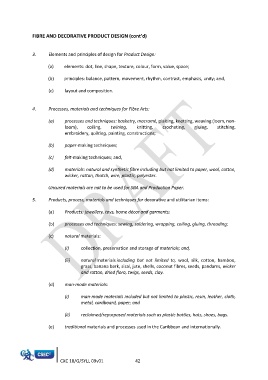Page 1443 - SUBSEC October 2017_Neat
P. 1443
FIBRE AND DECORATIVE PRODUCT DESIGN (cont’d)
3. Elements and principles of design for Product Design:
(a) elements: dot, line, shape, texture, colour, form, value, space;
(b) principles: balance, pattern, movement, rhythm, contrast, emphasis, unity; and,
(c) layout and composition.
4. Processes, materials and techniques for Fibre Arts:
(a) processes and techniques: basketry, macramé, plaiting, knotting, weaving (loom, non-
loom), coiling, twining, knitting, crocheting, gluing, stitching,
embroidery, quilting, painting, constructions;
(b) paper-making techniques;
(c) felt-making techniques; and,
(d) materials: natural and synthetic fibre including but not limited to paper, wool, cotton,
wicker, rattan, thatch, wire, plastic, polyester.
Uncured materials are not to be used for SBA and Production Paper.
5. Products, process, materials and techniques for decorative and utilitarian items:
(a) Products: jewellery, toys, home décor and garments;
(b) processes and techniques: sewing, soldering, wrapping, coiling, gluing, threading;
(c) natural materials:
(i) collection, preservation and storage of materials; and,
(ii) natural materials including but not limited to, wool, silk, cotton, bamboo,
grass, banana bark, sisal, jute, shells, coconut fibres, seeds, pandams, wicker
and rattan, dried flora, twigs, seeds, clay.
(d) man-made materials:
(i) man-made materials included but not limited to plastic, resin, leather, cloth,
metal, cardboard, paper; and
(ii) reclaimed/repurposed materials such as plastic bottles, hats, shoes, bags.
(e) traditional materials and processes used in the Caribbean and internationally.
CXC 18/G/SYLL 09v01 42

